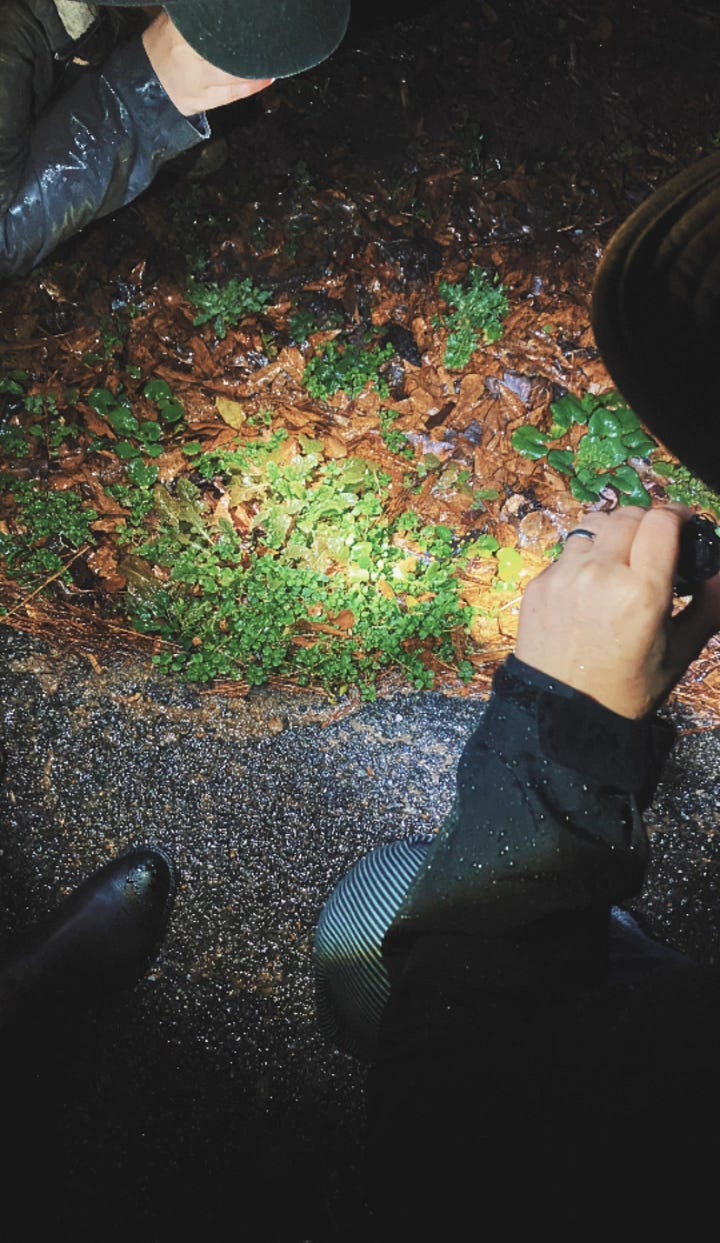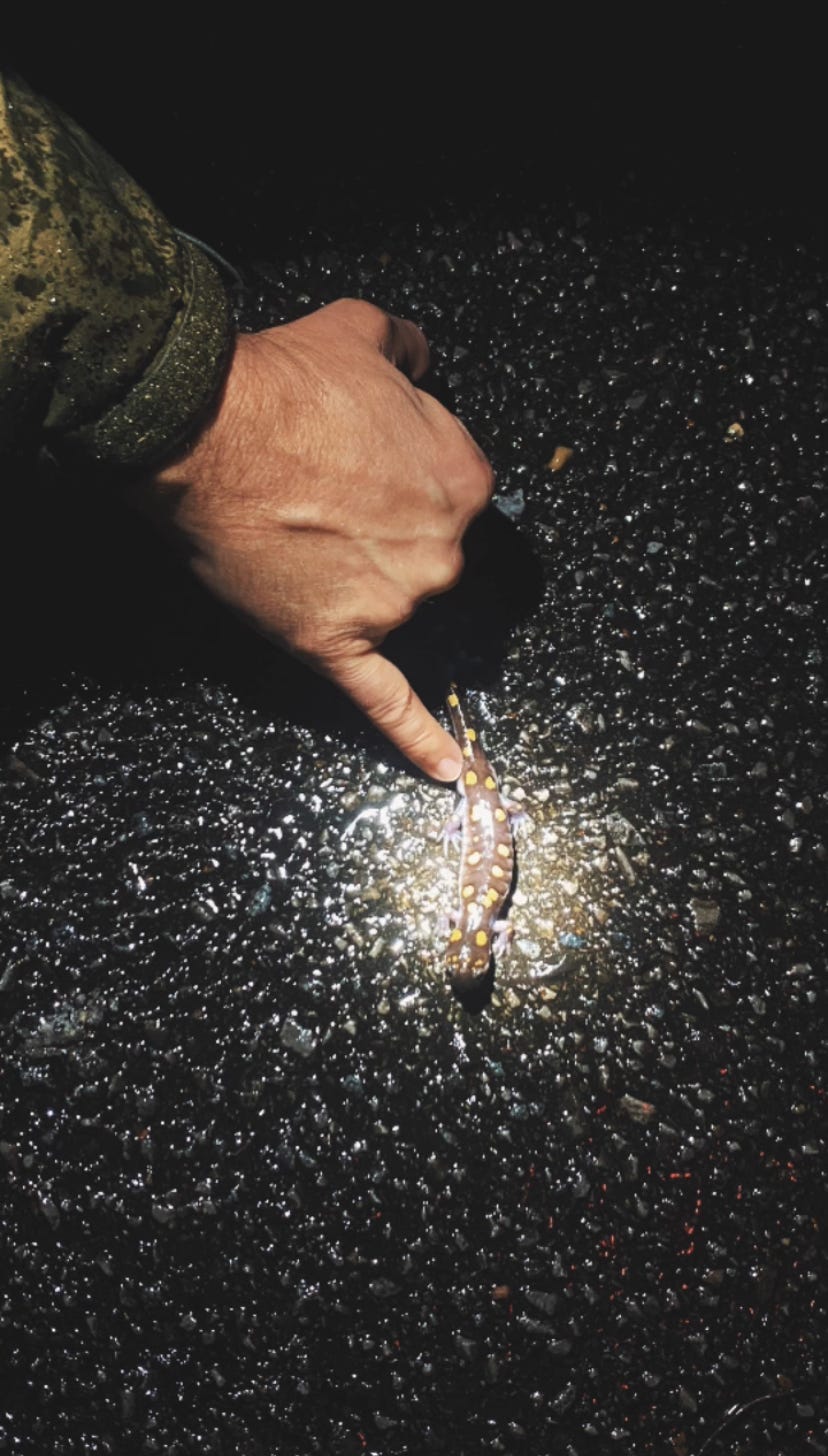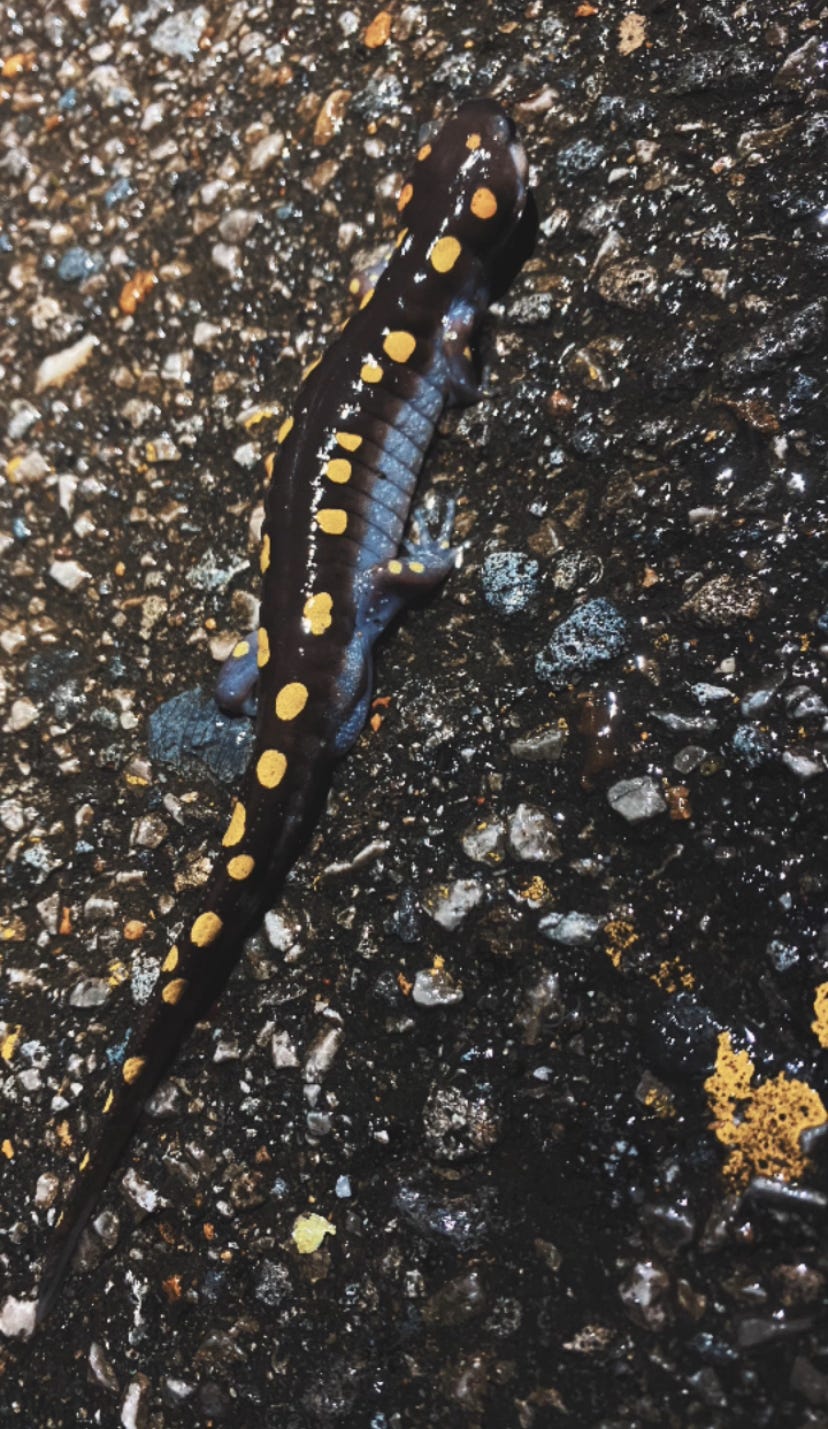Dear Reader,
When everyone is picking out Valentine’s Day cards, double checking their dinner reservations or buying that last minute bouquet of flowers, yellow spotted salamanders are planning their own romantic evenings.
When the sun goes down and rain starts to fall, spotted salamanders know it’s time to come out. There’s something in the balmy 50ish degree air that tells them that tonight is the perfect night to procreate, to mingle, to make babies. That is the night they paint the town and show off their yellow splotches for interested partners.
In Homewood, Alabama, just behind the high school there is a nature preserve that used to belong to Howard College (now known as Samford). These amphibians have to cross a busy road in order to make it to the mating pools. They’re looking for any body of water that might be a good place to lay fertilized eggs. Volunteers from the Friends of Shades Creek come out and put up road blocks and count how many they see. Earlier this week was one of the last times this season we had the opportunity to see them come down from the mountain.
I was the first of our group to arrive. As I walked towards the beginning of the road one of the volunteers pointed her flashlight a few feet away from me and said, “Be careful, you don’t want to step on one.”
Immediately the slithery creature paused, it became frozen under the light. I suppose it was trying to decipher if we were friends or foes. Their purple black bodies blend into the asphalt, their gold spots could be mistaken from long decayed yellow paint used to mark the road.
Salamanders are shy in nature. They like to hide in the ground or under a log, their bodies are the ultimate camouflage against the road. Recently, I’ve felt a similar sting. Unlike the spotted salamander, shyness is new to me.
Many of my friends and family will tell you that I can be friends with anyone. I don’t mind asking the waiter at the restaurant for a side of dressing someone was too scared to ask for, I love introducing people to each other thus expanding our circles, I will jump at any opportunity to socialize with friends and family but the past few years there have been periods of time where I freeze in these situations. In these moments that may stretch into days, I feel like a shell of who I thought I was.
The feeling appears out of nowhere. I’m at an event or I plan to go to one and I realize that I will have to navigate something alone. It’s a jarring realization like I’ve forgotten to speak the only language I know how. Other times I’m meeting with a group and it feels like I’m on the edge of everything, as if there is a circle and I’m a little dot just outside of it.
When searching for salamanders you have to think like them. Walk slowly, keep an eye out for the slightest wiggle or flopping of tiny toes. Aid in their safe journey by watching them crawl from over the asphalt into a pile of lush greens and winter leaves. They’ll find themselves in the mating pools and look for their other half. Well . . . their other half for the night that is.


When light approaches they might pause and squirm against the woodsy floor for a moment before continuing their journey. You have to make a salamander feel at home. On nights when romance strikes, they don’t feel like hosting human neighbors. They say, “Thank you for visiting, but come another time, we’re busy here!”
Being on the outside of this particular circle isn’t such a bad thing. There’s a comfort in exploring solo, of finding friends halfway or seeing a collection of flashlights pointed one way and joining them.
In these bursts of shyness, everyone around me probably assumes everything is normal. I’m still smiling and laughing, but on the inside, I’m looking for a way to escape, to cross the road. Those days I feel like one of these salamanders, trying to move through life and suddenly a giant fluorescent flashlight glares at me. It’s a freezing feeling, like a polar plunge and you left your change of warm clothes at home.
I said in a previous letter that I feel most like myself when it rains. It was true on this night out in Homewood. Our group was huddled in the middle of the road when a familiar face approached. Paul Freeman, wearing rain boots and a brimmed rain hat recognized some of our faces. Paul currently serves on the Board of Directors for Shades Creek and spent several years in his roles at the Tennessee Valley Authority and The Nature Conservancy. When Paul shows up we know we’re going to be treated to one if not many little science lessons.
He asked us for our tally and turned to see a salamander crawling towards him. He squatted down to point at her belly and swollen cloaca, a gland above their tail. Soon we were all crouched down as a mild rain slapped against our jackets and umbrellas. We looked at the different spots and wondered if we could keep track of all the patterns that passed through these trees. In a wonderful gasp, we pointed out their yellow spotted knees, recalling that we hadn’t noticed spots there before.
There is still a little mystery to this routine. We don’t really know when they return to the mountain. We know that the males come first and then the females. They lay their eggs in what they hope is a safe place but locals aren’t sure when exactly the mothers and fathers decide to return to their woodland homes. I imagine it would be similar conditions since these creatures prefer the rain and darkness but who knows? Nature often surprises us.
Returning to the nature preserve and observing these spotted salamanders reinforces what I’ve told you before, dear reader. I’m partial to aquatic beings. I’m partial to the creatures that are colorful and quiet, the ones that like to feel the rain and hide away. When I am with these creatures I feel as though I am truly connected with myself and this beautiful place I call home—even when shyness strikes.
Also:
@nativehabitatproject on Instagram got to visit with these creatures too (Thank you to Tina Braziel for sending this to me!)
Did the whale in Chile mean to (temporarily) swallow that kayaker? (hint: the answer is no) | NPR






